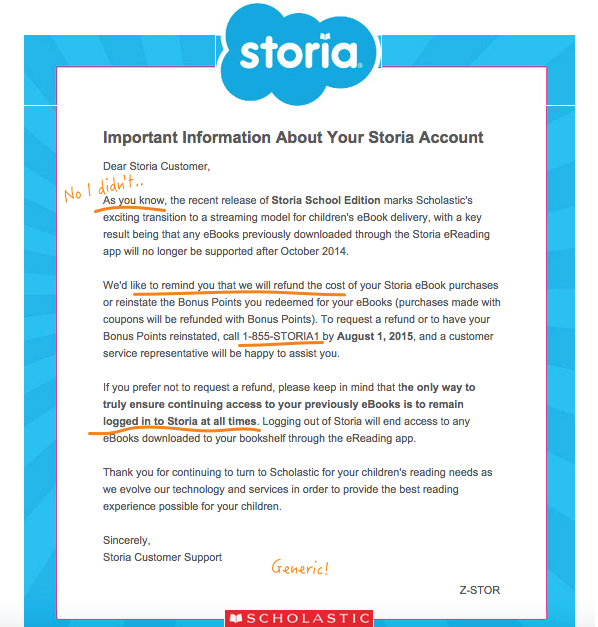One of my mom’s favorite sayings was “the road to hell is paved with good intentions.” This common phrase helps us look at what we actually do, not just the reasons behind it. Words mean little without actions to support them. Just saying you’re customer-centric isn’t enough.
Recently, I received an email about an e-reader service I had paid for a long time ago. The service was going away, and the email was telling me I was able to refund my purchases since I would no longer have access to them.
Customer or company focused?
When I saw the email, I had no idea the service was sunsetting. I must’ve missed that memo. So imagine my surprise when I saw the first line as:
“As you know…”
I had no idea.
Then the refund option – great news! This is proactive and thoughtful. And yet the letter was really a set of instructions for me, the customer, to get a refund. The alternative of never logging out of the system doesn’t strike me as a sustainable model.
I’m sure the intention was to try to help everyone who might complain about losing the service. Instead, it creates a lot of additional effort for the customers. And the signature? Why not provide a person’s name? The whole thing was nice, but lacking.
The biggest problem: the onus was completely on me to handle it.
I had to call the generic customer service number that was only open at certain times, get transferred a few times, receive a callback(!), wait on hold, and then finally find out I had a refund. To do this, I had to set a reminder in my calendar so I wouldn’t just remember it at midnight, spend several minutes on the phone the first time, and then get a callback to finish the process. The last email said the refund would appear in three days.
I imagine the intentions here were good ones. They proactively offered refunds instead of waiting for the discovery of a missing service and the complaints to pour in. Bravo! But the execution of how they handled this was squarely company-focused, and not really about the customer.
A few words of advice for translating your great intention into actual customer-centric communications:
1. Don’t assume.
It’s not fair to assume your customers, who don’t live and breathe your brand as you do, know very much about what’s happening. I’ve written before about how marketers obsess over their brands and often assume the customers care as much about it. They don’t.
2. Avoid “next new thing” obsession.
In this email, they tried to paint this as an “exciting transition” to another service offering. It’s not that exciting to a loyal customer of your other service. And since the customer won’t have access to the service already paid for, it is less than exciting.
3. Reduce your customer’s effort.
In the case of my letter, it was up to me to call the service number (only available at certain times), speak with several different reps, stay on hold and finally receive confirmation I had indeed received what was originally promised in the thoughtful, proactive communication. :)
I am baffled with why, if they were prepared to give refunds, didn’t they give the refund and then inform the customers this was already handled? I’m sure there are limitations in how they could do this. I’m betting they are playing a bit of a numbers game with the number of customers who might remember versus those who would just let it go. But the great intentions of treating the customers well morphed into additional effort for the customer.
Scholastic was doing the right thing here. They just were doing it their way instead of the customer’s way.
Next time you have great intentions, consider the actions and words you are using to communicate them to customers. Nobody wants to end up in customer experience hell.

